2. Energy efficiency
2.1 FOCUS ON ENERGY
Defence capability is dependent on energy to fuel the fleets and equipment of the Canadian Armed Forces. It provides soldiers with portable power and sustains military camps, some of which are located in difficult or extreme environments that draw heavily on energy resources. Defence also operates and maintains an extensive range of infrastructure across the country, extending as far north as the High Arctic. Having access to reliable, affordable energy, when and where it is needed, is necessary to ensure Defence capability, operational readiness, sustainability, and responsiveness by the Defence Team to deliver on its mandate.
As the largest user of energy and the single largest emitter of GHGs in the federal government, Defence has a key role to play in helping the GoC reach its net-zero targets. The DEES provides the strategic direction to help the Defence Team consider energy and environmental factors in all areas of our business. Defence will play a leadership role in reducing GHG emissions from its infrastructure and commercial light-duty vehicle fleets, where feasible, with a commitment to reduce these emissions by 40% (below 2005 levels) by 2025 and to achieve net-zero emissions by 2050.
While GHG reduction opportunities exist within all aspects of the operational portfolio, reducing emissions from military fleets and operations are more challenging. Reliable low-carbon and renewable fuels are not yet broadly available to power the essential military equipment Defence needs. In support of the net zero objective, Defence will continue to report these emissions, and support innovative approaches to increase energy efficiency and reduce GHG emissions from military activities without compromising capabilities or operations.
Reduce greenhouse gas emissions by 40% below 20051 levels by 2025 and achieve net-zero emissions by 2050
1 Targeting emissions from an infrastructure and commercial light-duty fleet
2.2 IMPROVING THE ENERGY EFFICIENCY OF BASES AND WINGS
IMPLEMENTING AN ENERGY FRAMEWORK
Defence has energy managers who identify, implement, and maintain efficiency measures for all bases and wings. Energy managers are the local energy champions and technical experts that integrate energy-engineering principles into base operations to increase the efficiency and sustainability of our infrastructure. Moving forward, an operational-level energy framework will integrate strategic energy programs, goals, and priorities, and guide the development of regional-level energy management plans. The framework, and subsequent plans, will provide an effective communication and planning tool for initiatives at the local, regional and national levels. Investing in building metering will be key to reporting on the impact of base/ wing-level energy plans.
In 2017, Defence and the National Research Council launched a pilot project to install smart building technology at five CAF facilities. The equipment measures the energy consumption of various building systems including lighting, electrical, heating, cooling, and the energy efficiency of the building envelope. The data collected is used to increase building performance and achieve energy and operational efficiency.
CLEAN ENERGY PROCUREMENT
Buying clean power from regional grids can be a very cost effective way to reduce GHG emissions from our buildings. Buying electricity from renewable sources also supports investments in green infrastructure and clean technology, and promotes innovation in the natural resources sector. Defence is committed to purchasing clean power as it becomes available.
In 2019-20, 74% of all electricity used to power our bases and wings in provinces with carbon-intensive electrical grids2 came from clean sources. About 10% of DND’s 31% reduction in GHG emissions comes from purchasing clean electricity for defence facilities in Alberta alone. This bulk electricity contract provides green or renewable energy for 90% of our electricity needs in the province.
We will continue to invest in renewable energy contracts to meet the government’s target of using 100% clean electricity at all federal facilities by 2022, where available. We are also working with other federal departments to purchase clean electricity from new sources, like solar power, to run our bases in Alberta and New Brunswick.
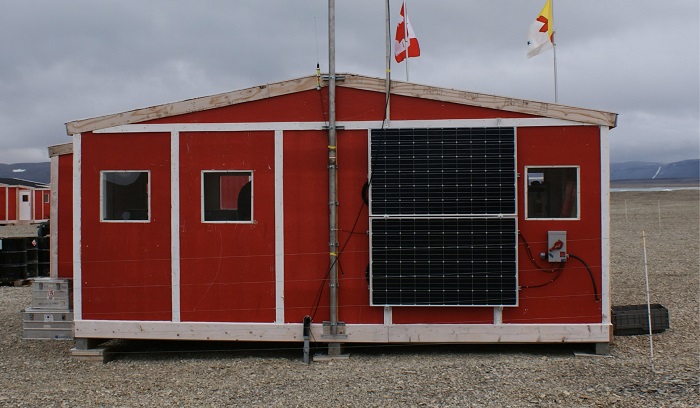
Renewable energy sources such as wind, solar, geothermal, synthetic fuels and other energy alternatives, will continue to evolve and offer more energy options, diversify the energy supply, increase the security of the fuel supply chain, and help reduce GHG emissions. Defence will be developing low-emission electrical micro-grids at select installations in the High Arctic. These micro-grids will reduce our GHG emissions in the Arctic while significantly reducing our reliance on fossil fuel in the North.
Use 100% clean electricity by 2022, where available, and by 2025 at the latest by producing or purchasing renewable electricity
REDUCING RELIANCE ON DIESEL FUEL GENERATED POWER
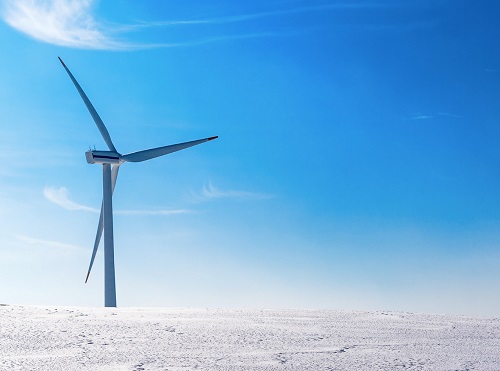
ENERGY PERFORMANCE CONTRACTS
The energy sector is changing rapidly. New and emerging technologies, innovations and partnerships create opportunities that were previously unthinkable. Implementing energy performance contracts (EPCs) at our bases minimizes up-front costs to the taxpayer, and guarantees that the upgrades produce real savings.
Through an EPC, a company is hired to pay for and carry out an energy retrofit project at a base or wing. The money saved in energy costs is then used to pay the company back over a 5- to 15-year period. As of March 2020, Defence had implemented 11 EPCs on bases and wings across Canada and more are planned. Defence will continue to assess the portfolio to determine where EPCs would be of benefit.
We are currently working on an EPC at CFS Alert, where building upgrades could see a more than 40% reduction in heating fuel consumption leading to significant reductions in GHG emissions. This is especially important for a facility like Alert, which relies on fuel being transported in to generate energy.
LEVERAGING GREEN PARTNERSHIPS
Our energy performance contracts are on track to reduce annual GHG emissions by 22,209 tonnes of CO2 equivalent, and save about $5.7 million in annual energy costs. Energy performance contracts are being implemented at base Petawawa, Bagotville, Greenwood, Valcartier and Esquimalt.GREEN BUILDINGS
Defence is committed to contributing to the GoC’s targets for GHG reductions, climate change adaptation, and infrastructure resilience and sustainability, by integrating these concepts when designing, building, and renovating Defence’s facilities. We are supporting the National Research Council to develop updated building codes that incorporate resilience to the potential impacts from climate change. We are also updating our Green Building Directive to reduce GHG emissions and ensure delivery of modern sustainable buildings in the Defence portfolio. The Green Building Directive will provide guidance and targets for non-fossil fuel heating sources, smart building controls, reducing energy loss, minimizing construction, renovation and demolition waste, and building to the latest industry standards for green construction, such as LEED Silver or Three Green Globes.
Preventative maintenance is an important activity to ensure we continue to see energy reductions in our buildings over time. Facility and equipment maintenance ensures energy savings from net-zero construction and energy performance contracts are not lost. Preventative maintenance also helps infrastructure withstand the impacts of climate change, such as extreme weather events and natural disasters.
TARGET 4 Revise the Green Building Directive to include construction, renovation and demolition waste, net-zero, and available industry standards on embedded carbon requirements by 2021
Green building and energy efficiency are also an important part of the Canadian Forces Housing Agency’s (CFHA) business. Housing renovations typically include the replacement of all systems as well as upgrades to insulation and other components that improve the overall energy efficiency of homes. These changes improve the energy efficiency of Defence housing across Canada and ensure our military families have comfortable, contemporary homes with lower monthly utility costs.
From 2017-2020, the CFHA assessed all new construction and whole house renovations using Natural Resource Canada’s EnerGuide for Houses (EGH) program. CFHA’s assessments confirmed that these renovations are consistently reducing the overall energy consumption of the housing portfolio. CFHA will continue to use this assessment tool to improve the energy efficiency of military housing. The CFHA will also develop net-zero carbon ready designs for 2 of its residential housing models by 2023. A net-zero carbon ready building is a highly efficient structure that produces or buys carbon-free renewable energy that off-sets the carbon emissions associated with its annual operation. Residential housing models or styles include multi-unit residential buildings up to 12 units, single home, semi-detached, and row houses.
CFHA ENERGY ASSESSMENTS

14 WING GREENWOOD
Whole house renovations reduced energy consumption by 21 GJ a year which is equivalent to 42 BBQ propane tanks.2.3 MODERNIZING THE COMMERCIAL LIGHT-DUTY VEHICLE FLEET
Defence has adopted an aggressive approach to reducing GHG emissions from our commercial light-duty vehicle fleet. As of 2019-20, 33% of Defence’s commercial light duty fleet were hybrid, plug-in hybrid and zero-emission vehicles, and 84% of new purchases were green vehicles. We are continuing to look for opportunities to replace our vehicle fleet with greener options. A second wave of green vehicle procurement is planned. All new commercial light-duty vehicle purchases will be green vehicles where the option is available and operationally feasible. Defence will continue to examine other green solutions, such as converting internal combustion engines to plug-in hybrid, tracking the performance of our vehicles and testing hydrogen vehicles. We are currently testing a hydrogen vehicle at CFB Valcartier in collaboration with Natural Resources Canada (NRCan). To support the new fleet of zero-emission vehicles, we will continue to install electric charging stations at our buildings.
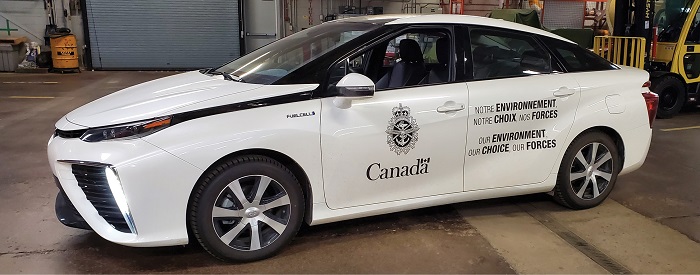
TARGET 6 100% of DND commercial light-duty vehicle fleet purchases will be zero-emission vehicles (ZEVs) or hybrid when available, with a ZEV procurement target of 50% by 2023
2.4 IMPLEMENTING INNOVATIVE ENERGY SOLUTIONS FOR MILITARY ACTIVITIES AND OPERATIONS
USING CLEANER FUELS FOR THE MILITARY FLEET
Fuel to power the CAF is necessary to ensure national safety and security for Canadians. Defence recognizes the requirement to power our forces should be done as sustainably as possible without impacting safety and security.
Defence is working with other government departments to support efforts to create a sustainable aviation fuel supply chain in Canada. This supply chain could provide alternative fuel blends that meet military fuel standards, and are cost-competitive for use in the military fleet. Defence will consider using blends of sustainable fuels that meet military technical requirements and North Atlantic Treaty Organization (NATO) standards, when they are available and affordable. These standards allow us to maintain interoperability with allies, while increasing fuel security and military fleet resilience.
Defence continues to support NRCan’s Sky’s the Limit Challenge that encourages industry to develop a sustainable aviation fuel supply that could use existing fuel infrastructure without any equipment modifications. Until the fuel supply chain is ready, the RCAF will continue to prepare for the potential use of sustainable aviation fuels. This includes developing a strategy for aviation fuels that supports the government’s goal of achieving net-zero GHG emissions by 2050. As a first step, the RCAF will modernize its aviation fuel tracking system to assess fuel use throughout the fleet.
Energy efficiency improvements will also be carried out on the water. The RCN will optimize energy performance of its fleet through data analysis, and testing energy efficient technologies and processes. In the short term, the RCN will monitor energy consumption for the in-service fleet and measure improvements. Defence will adopt a forward looking approach to identify and trial emerging energy efficient technologies that could have a significant impact on the performance of the marine fleet.
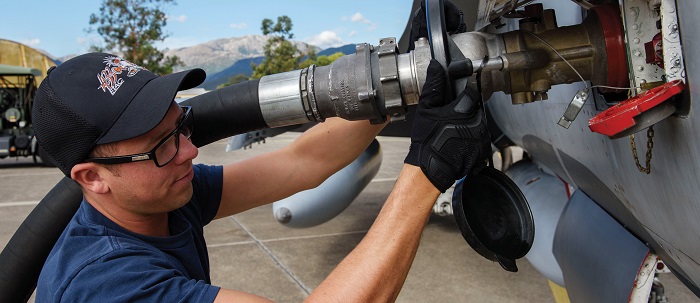
TARGET 7 Develop a strategy for aviation fuels that supports the Government of Canada’s goal of achieving net-zero GHG emissions by 2050
TARGET 8 Complete baseline energy and fuel usage evaluations for select marine vessels by 2023
DESIGNING MORE EFFICIENT SOLDIER EQUIPMENT AND KITS
Defence is studying options to improve the energy efficiency of soldier equipment and kits that also improve a soldiers’ ability to operate. Studies are underway to improve power management and wearable power sources that are needed to minimize the overall volume and weight burden for soldiers while enhancing their operational capability.
PROMOTING ENERGY CONSERVATION THROUGH AWARENESS AND TRAINING
Defence reduces overall energy use during military activities and operations by increasing awareness of green practices among personnel though training. Energy efficiency best practices are incorporated in internal processes and decision making at all leadership levels. Management is responsible for communicating and engaging with personnel so that energy is valued as a key strategic capability that enables operational readiness and lowers operational risks.
PROVIDING MORE EFFICIENT POWER SOLUTIONS FOR OPERATIONS
Deployed forces must sustain themselves in harsh environments for extended periods of time. There are also ever increasing costs and risks associated with securing traditional resources, such as fuel and water for these types of camps. This requires modern, energy efficient, flexible and scalable deployable camp infrastructure and utilities that minimize logistical demands and footprint. Defence is continuing to explore the potential for energy efficiency improvements during major deployed operations including using analytical tools to design more efficient camps. The new Camp Sustain equipment project will replace Defence’s aging and inefficient deployable camp equipment and ensure future operations have modern and efficient equipment. Alternative energy sources, such as wind and solar power, or shifting to host nation power, will be investigated to reduce our dependency on fossil fuels. We are also engaged in partnerships with NRCan, the NATO Science for Peace and Security program, Security Centre of Excellence to help monitor and manage operational energy use.
TARGET 9 Achieve an energy efficiency of 85% for fossil-fuel electrical generation and distribution utilities in major deployed camps by 2023
THE “POP-UP CITY” CONTEST
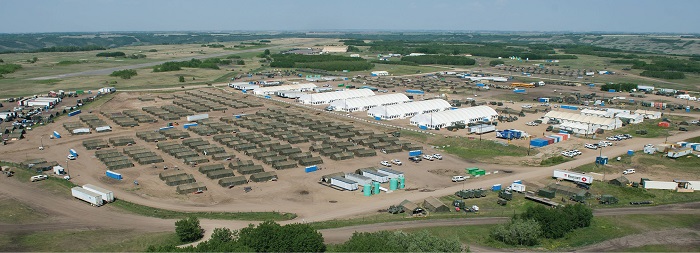
The CAF must be ready to deploy on short notice, in any climate and for long periods of time. The CAF relies on relocatable temporary camps for its deployments to sustain personnel in demanding operational and environmental conditions. The Pop-up City Contest is a multi-phased contest for innovators to propose and develop reliable, energy efficient, integrated and scalable energy, water and waste management systems for deployed military camps in national and international operations.